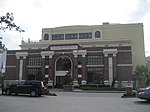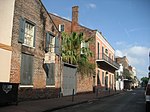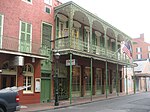Our Lady of Guadalupe Church & International Shrine of St. Jude
1826 establishments in Louisiana19th-century Roman Catholic church buildings in the United StatesAfrican-American Roman Catholic churchesAfrican-American Roman CatholicismLouisiana Voodoo ... and 3 more
Roman Catholic churches completed in 1826Roman Catholic churches in New OrleansRoman Catholic national shrines in the United States

Our Lady of Guadalupe Church & International Shrine of St. Jude is a Roman Catholic church located on Rampart Street in New Orleans, Louisiana. It is the oldest surviving church building in the city (originally established as the Chapel of St. Anthony of Padua), the back of the church is bordered by Basin Street, and the parish is predominantly African-American. The church is one of multiple parishes in the city that celebrates a weekly "Gospel Jazz Mass" on Sunday mornings.
Excerpt from the Wikipedia article Our Lady of Guadalupe Church & International Shrine of St. Jude (License: CC BY-SA 3.0, Authors, Images).Our Lady of Guadalupe Church & International Shrine of St. Jude
North Rampart Street, New Orleans Storyville
Geographical coordinates (GPS) Address Phone number Website Nearby Places Show on map
Geographical coordinates (GPS)
| Latitude | Longitude |
|---|---|
| N 29.9585 ° | E -90.0707 ° |
Address
Our Lady of Guadalupe Church
North Rampart Street 411
70112 New Orleans, Storyville
Louisiana, United States
Open on Google Maps











